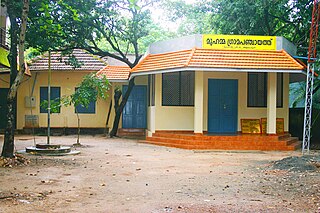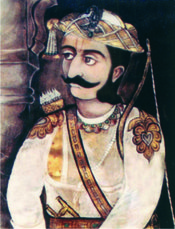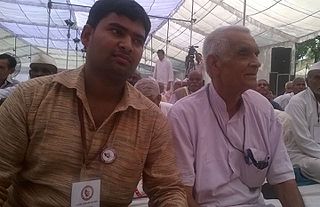Related Research Articles

The Connemara Public Library at Egmore in Chennai, Tamil Nadu, India, is one of the four National Depository Libraries which receive a copy of all books, newspapers and periodicals published in India. Established in 1896, the library is a repository of century-old publications, wherein lie some of the most respected works and collections in the history of the country. It also serves as a depository library for the United Nations. It is located in the Government Museum Complex on Pantheon Road, Egmore, which also houses the Government Museum and the National Art Gallery.

Bugyals are alpine pasture lands, or meadows, in higher elevation range between 3,300 metres (10,800 ft) and 4,000 metres (13,000 ft) of the Himalayas in the Indian state of Uttarakhand, where they are called "nature’s own gardens". The topography of the terrain is either flat or sloped. The surface of these bugyals is covered with natural green grass and seasonal flowers. They are used by tribal herdsmen to graze their cattle. During the winter season the alpine meadows remain snow-covered. During summer months, the Bugyals present a riot of beautiful flowers and grass. As bugyals constitute very fragile ecosystems, particular attention needs to be given for their conservation.

Panchayati Raj is the system of local self-government of villages in rural India as opposed to urban and suburban municipalities.

Sir Chintaman Dwarakanath Deshmukh, CIE, ICS was an Indian civil servant and the first Indian to be appointed the Governor of the Reserve Bank of India in 1943 by the British Raj authorities. He subsequently served as the Finance Minister in the Union Cabinet (1950–1956). It was during this time that he also became a founding member of the Governing Body of NCAER, the National Council of Applied Economic Research in New Delhi, India's first independent economic policy institute established in 1956 at the behest of Prime Minister Jawaharlal Nehru. After resignation from Union Cabinet he worked as Chairman of UGC (1956–1961). He served as Vice-Chancellor of University of Delhi (1962–67). He was also President of Indian Statistical Institute from 1945 to 1964, Honorary Chairman of National Book Trust (1957–60). He founded India International Center in 1959 and served as Lifetime President of it. He was also chairman of Indian Institute of Public Administration.

Raghoji I or Raghuji the Great of the Bhonsale dynasty, was a Maratha general who took control of the Nagpur Kingdom in east-central India during the reign of Shahu I. His successors ruled the kingdom until 1853.

Ramjee Singh is a former Member of Parliament and vice-chancellor of Jain Vishva Bharati University. He is an eminent Gandhian and is the author of a number of books on him. He was also the director of Gandhian Institute of Studies, Varanasi, India. In January 2020 he was awarded the fourth highest civilian award in the country: The Padma Shri for Social Work. His life has been a blend of being a Gandhian academician as well as an activist. Singh has declared Mahatma Gandhi as the Bodhisattva of the 20th century.
National Translation Mission (NTM) is a Government of India initiative to make knowledge texts accessible, in all 22 official languages of the Indian Republic listed in the VIII schedule of the Constitution, through translation. NTM was set up on the recommendation of the National Knowledge Commission. The Ministry of Human Resource Development has designated Central Institute of Indian Languages as the nodal organization for the operationalization of NTM.
Gopa or Gop or Gope is a synonym of the Yadav (Ahir) caste. It is generally used as a title by the Ahir caste in the states of Bihar, Jharkhand and West Bengal of East India and even in Terai region of Nepal.
Adikanda Mahanta is an Indian folklorist from Chitrada, Odisha. He is one of the pioneer folklorists of Odisha and is well known for his research on folk culture of eastern India. He was awarded a doctoral degree from Ranchi university for his research work on the folk culture of Odisha for his research thesis "Odishara Kurmali Lokagita". Professionally, Mohanta is an S.I. of School, an employee of the Odisha state government.

Swami Vivekananda (1863–1902) was an Indian Hindu monk and a key figure in the introduction of Indian philosophies of Vedanta and Yoga to the western world. He was one of the most influential philosophers and social reformers in his contemporary India and the most successful and influential missionaries of Vedanta to the Western world. Indian Nobel laureate poet Rabindranath Tagore's suggested to study the works of Vivekananda to understand India. He also told, in Vivekananda there was nothing negative, but everything positive.
Eurasianet is a news organisation based at Columbia University's Harriman Institute, the United States, that provides news, information and analysis on countries in Central Asia, the Caucasus region, Russia and Southwest Asia. Launched in 2000, it operated under the auspices of the Eurasia Project of the Open Society Foundations (OSF). Eurasianet spun off in 2016 to become an independent, tax-exempt non-profit news organization. The site receives support from Google, OSF and the National Endowment for Democracy.

Virender Lal Chopra was an Indian biotechnologist, geneticist, agriculturalist and a director-general of the Indian Council of Agricultural Research (ICAR), known to have contributed to the development of wheat production in India. He was the chancellor of Central University of Kerala, a Chancellor of the Central Agricultural University, Imphal and a member of the Planning Commission of India. An elected fellow of several science academies such as Indian Academy of Sciences, Indian National Science Academy, National Academy of Agricultural Sciences, National Academy of Sciences, India, European Academy of Sciences and Arts and The World Academy of Sciences (TWAS), he was a recipient of a number of honors including Borlaug Award, FAO World Food Day Award and Om Prakash Bhasin Award. The Government of India awarded him the third highest civilian honour of the Padma Bhushan, in 1985, for his contributions to agricultural science.
Narinder Singh Randhawa (1927–1996) was an Indian agricultural scientist, writer and the director general of the Indian Council of Agricultural Research (ICAR). He was the president of the Indian Society of Soil Science during 1980–81 term and was a recipient of National Citizen Award and Rafi Ahmed Kidwai Award of the Indian Council of Agricultural Research. The Government of India awarded him the third highest civilian honour of the Padma Bhushan, in 1989, for his contributions to agricultural science.
Sardul Singh Guraya (1930–2012) was an Indian biologist, known for his contributions in the fields of reproductive physiology and Developmental biology. He was an elected fellow of the Indian National Science Academy, National Academy of Sciences, India and National Academy of Agricultural Sciences. The Council of Scientific and Industrial Research, the apex agency of the Government of India for scientific research, awarded him the Shanti Swarup Bhatnagar Prize for Science and Technology, one of the highest Indian science awards, in 1973, for his contributions to biological sciences.
Gaya Prasad Pal is an Indian anatomist, professor and the director of Modern Institute of Medical Sciences, Indore. An elected fellow of the National Academy of Medical Sciences, Indian Academy of Sciences and National Academy of Sciences, India, Pal is known for his researches on biomechanics and load transmission of human spinal column. The Council of Scientific and Industrial Research, the apex agency of the Government of India for scientific research, awarded him the Shanti Swarup Bhatnagar Prize for Science and Technology, one of the highest Indian science awards for his contributions to Medical Sciences in 1993.
Italy is the home of two of the world's biggest publishers of books in terms of revenue: Messaggerie Italiane and Mondadori Libri. Other large publishers include De Agostini Editore, Feltrinelli and the RCS MediaGroup.

Nongthang Leima is the goddess of seduction, thunder and lightning in Meitei mythology and religion. She was created by Atingkok to attract Haraba (Pakhangba). She mastered thunder and lightning in the chaos in the early world. She predicted the first rain. She limits the chaos and helps creation.
This is a bibliography of notable works about Nepal.

The Bhonsles of Nagpur were a Maratha royal house that ruled the Kingdom of Nagpur from 1739-1853. They hailed from the Bhonsle clan of Marathas and were one of the most important and powerful Maratha chiefs in the Maratha Empire.

Meitei mythology or Manipuri mythology is a collection of myths, belonging to the religious and cultural traditions of the Meitei people, the predominant ethnic group of Manipur. It is associated with traditional Meitei religion (Sanamahism). Meitei myths are a part of Meitei culture and explain various natural phenomena, how the human civilization developed, and the reasons of many things happening. Most of the Meitei legends are found in the Meitei language texts.
References
- ↑ "Central Reference Library". Indian Culture. Retrieved 2022-11-13.
- ↑ Chilana, Rajwant Singh (2008). Challenges for South Asian Resources and Information Services: Essays in Honour of Dr. Ravindra N. Sharma. Concept Publishing Company. ISBN 978-81-8069-527-8.
- ↑ Rao, Dr M. Koteswara (2011-10-07). Corporate Social Responsibility and Public Libraries: Building a Sustainable Knowledge Society. Allied Publishers. ISBN 978-81-8424-710-7.
- ↑ Library Science and Administration. IGI Global. 2017-11-30. ISBN 978-1-5225-3915-5.
- ↑ Singh, Sahib (2003). Library and Literacy Movement for National Development. Concept Publishing Company. ISBN 978-81-8069-065-5.
- ↑ McDonald, John D.; Levine-Clark, Michael (2017-03-15). Encyclopedia of Library and Information Sciences. CRC Press. ISBN 978-1-000-03154-6.